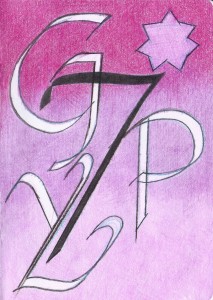The Sketchbook Project “is the world’s largest library of artists’ books…” The sketchbooks also travel North America and even the world via the Mobile Library. For more information, go to https://www.sketchbookproject.com.
I participated in the Sketchbook Project in 2012 and 2013. It’s time to take part again. This year’s theme is Numerology and the visual power of numbers and letters and their relationship to each other.
“The universe is based on the fundamental reality that all things are related and within that underlying notion of unity, all things are energy.”
from The Complete Idiot’s Guide to Numerology
The Number 7 is the number of solitude, contemplation, inner wisdom and mysticism. The number 7 is found in the universe (much like other numbers like the 3 and the 4):
7 days of the week
7 days in each moon phase
7 colors of the spectrum
7 notes on the musical scale
7 energy centers (chakras)
The symbol of the number 7 is the seven pointed star and the seven-branched Tree of Life.
Associated with the Number 7 is the color purple and the letters G, P and Y.
For further reading:
Lagerquist, Kay. The Complete Idiot’s Guide to Numerology. Indianapolis, IN: Alpha Books, 1999.
Millman, Don. The Life You Were Born to Live. Tiburon, CA: H. J. Kramer/New World Library, 1993.
Pythagoras and Numerology
Numerology is the study of the meanings of names and numbers and their relationship to each other and has its roots in the cultures of ancient Greece, China, Rome and Egypt and the Hebrew Kabbalah.
Pythagoras was a Greek mathematician and mystic from the 6th century B.C.E. He is one of the fathers of numerology and regarded as the father of geometry.
He based his system of names and numbers on his belief that nature is composed of numerical relationships. Numbers are a source of form and energy and numbers 1 through 9 represent the nine stages of the cycle of life.
Pythagoras and his followers believed that divine law could be calculated through mathematics.
Pythagoras, however, associated numbers with many ideas not just divine law. For example, he explored musical harmony through mathematics and called his concept “The Music of the Spheres.” Pythagoras believed that everything vibrates to its own special harmony; the higher the vibration, the more (or positive) force it has but the lower the rate of vibration, the less (or negative) force it has.




